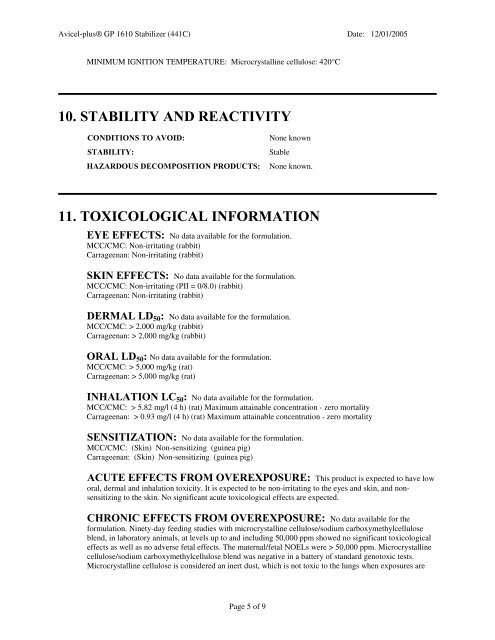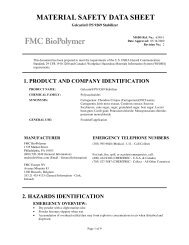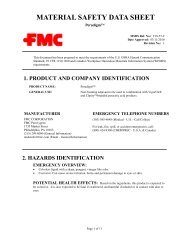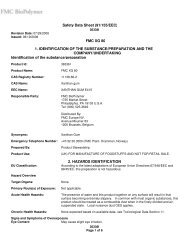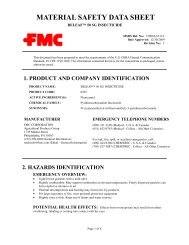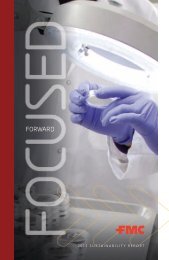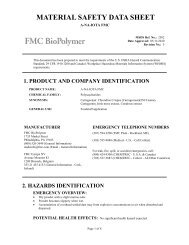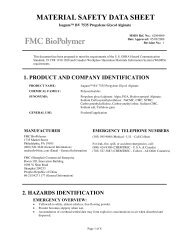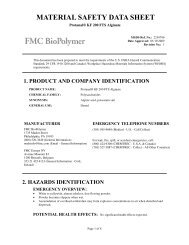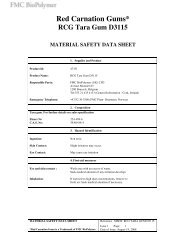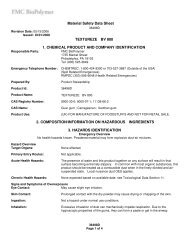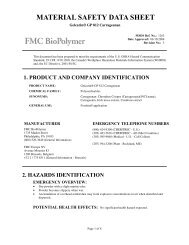Avicel-plus® GP 1610 Stabilizer - FMC Corporation
Avicel-plus® GP 1610 Stabilizer - FMC Corporation
Avicel-plus® GP 1610 Stabilizer - FMC Corporation
Create successful ePaper yourself
Turn your PDF publications into a flip-book with our unique Google optimized e-Paper software.
<strong>Avicel</strong>-<strong>plus®</strong> <strong>GP</strong> <strong>1610</strong> <strong>Stabilizer</strong> (441C) Date: 12/01/2005<br />
MINIMUM IGNITION TEMPERATURE: Microcrystalline cellulose: 420°C<br />
10. STABILITY AND REACTIVITY<br />
CONDITIONS TO AVOID: None known<br />
STABILITY: Stable<br />
HAZARDOUS DECOMPOSITION PRODUCTS: None known.<br />
11. TOXICOLOGICAL INFORMATION<br />
EYE EFFECTS: No data available for the formulation.<br />
MCC/CMC: Non-irritating (rabbit)<br />
Carrageenan: Non-irritating (rabbit)<br />
SKIN EFFECTS: No data available for the formulation.<br />
MCC/CMC: Non-irritating (PII = 0/8.0) (rabbit)<br />
Carrageenan: Non-irritating (rabbit)<br />
DERMAL LD50: No data available for the formulation.<br />
MCC/CMC: > 2,000 mg/kg (rabbit)<br />
Carrageenan: > 2,000 mg/kg (rabbit)<br />
ORAL LD50: No data available for the formulation.<br />
MCC/CMC: > 5,000 mg/kg (rat)<br />
Carrageenan: > 5,000 mg/kg (rat)<br />
INHALATION LC50: No data available for the formulation.<br />
MCC/CMC: > 5.82 mg/l (4 h) (rat) Maximum attainable concentration - zero mortality<br />
Carrageenan: > 0.93 mg/l (4 h) (rat) Maximum attainable concentration - zero mortality<br />
SENSITIZATION: No data available for the formulation.<br />
MCC/CMC: (Skin) Non-sensitizing (guinea pig)<br />
Carrageenan: (Skin) Non-sensitizing (guinea pig)<br />
ACUTE EFFECTS FROM OVEREXPOSURE: This product is expected to have low<br />
oral, dermal and inhalation toxicity. It is expected to be non-irritating to the eyes and skin, and nonsensitizing<br />
to the skin. No significant acute toxicological effects are expected.<br />
CHRONIC EFFECTS FROM OVEREXPOSURE: No data available for the<br />
formulation. Ninety-day feeding studies with microcrystalline cellulose/sodium carboxymethylcellulose<br />
blend, in laboratory animals, at levels up to and including 50,000 ppm showed no significant toxicological<br />
effects as well as no adverse fetal effects. The maternal/fetal NOELs were > 50,000 ppm. Microcrystalline<br />
cellulose/sodium carboxymethylcellulose blend was negative in a battery of standard genotoxic tests.<br />
Microcrystalline cellulose is considered an inert dust, which is not toxic to the lungs when exposures are<br />
Page 5 of 9


